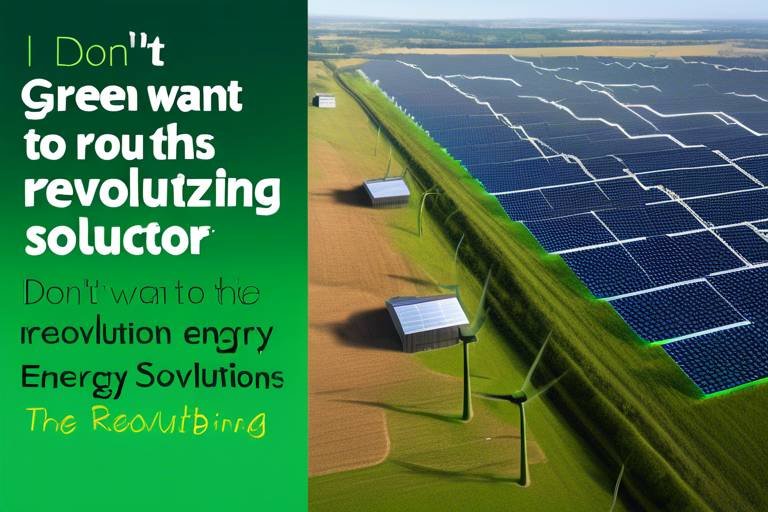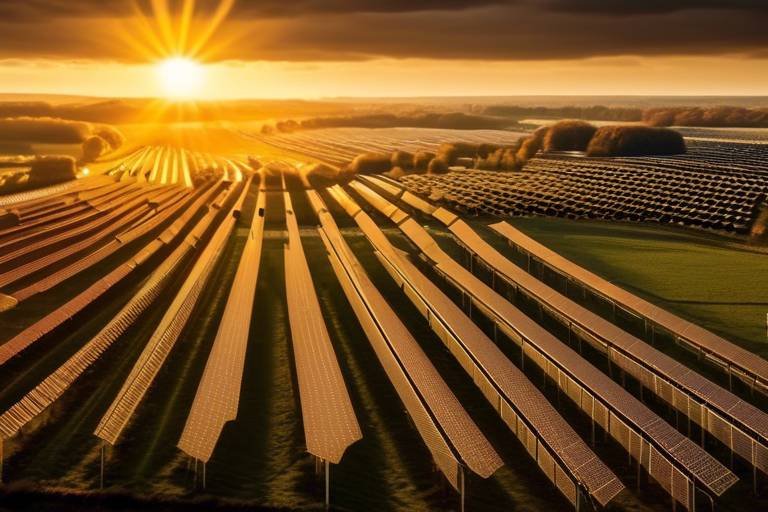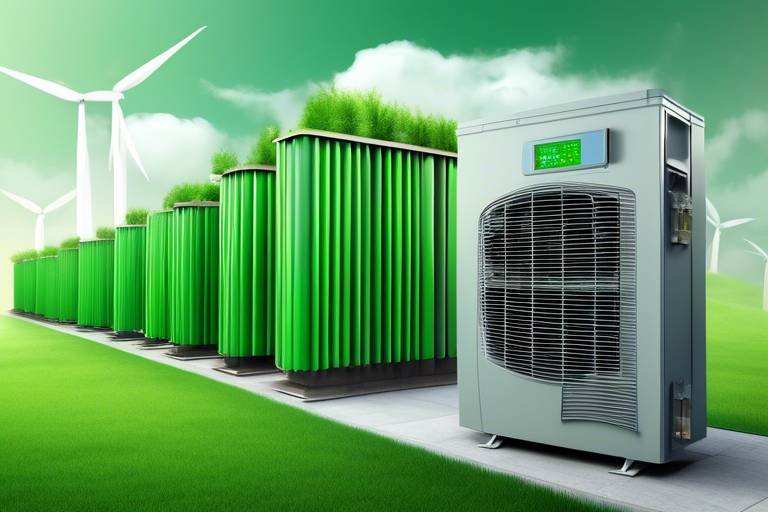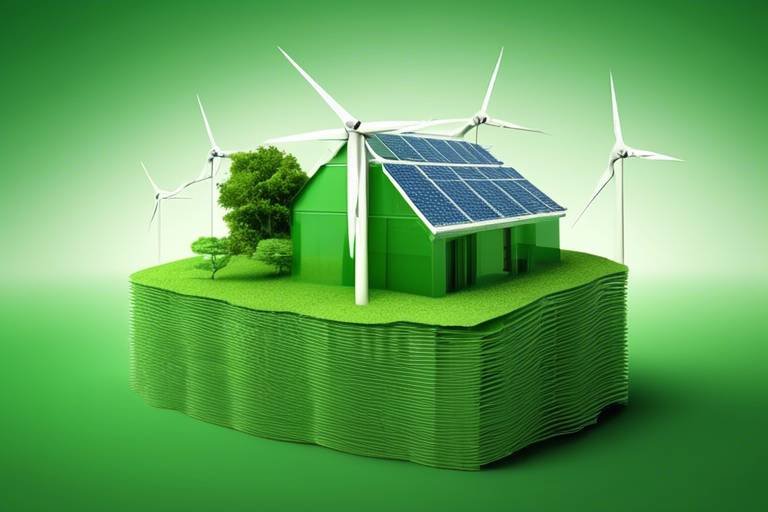Are Local Governments Investing Enough in Green Energy?
The question of whether local governments are investing enough in green energy is not just a matter of numbers; it’s about our future. As communities grapple with the pressing challenges of climate change, the urgency for sustainable energy solutions has never been more critical. Local governments, often seen as the frontline warriors in the battle against environmental degradation, hold significant power in driving sustainable initiatives. However, the reality is a mixed bag. While some municipalities are blazing trails in renewable energy, others lag behind, hindered by various challenges. So, are they doing enough? Let’s dive into the current landscape of local government investments in green energy and uncover the successes, hurdles, and what lies ahead.
In recent years, there has been a noticeable shift in how local governments allocate their budgets, with a growing emphasis on green energy projects. This trend reflects a broader recognition of the need for sustainable practices that reduce carbon footprints and promote environmental health. Local governments are increasingly funding various initiatives, including:
- Solar Energy Installations: Many cities are investing in solar panels for public buildings and facilities, harnessing the sun's power to reduce energy costs.
- Wind Farms: Some communities are exploring wind energy options, taking advantage of their geographic locations to generate clean energy.
- Biomass Projects: Utilizing organic materials for energy production has gained traction, especially in rural areas.
These investments not only contribute to local energy independence but also create job opportunities and stimulate the economy. However, the overall financial commitment to sustainability varies widely across different regions, often influenced by local priorities and available resources.
Despite the positive trends, local governments face numerous challenges when it comes to investing in green energy. Understanding these hurdles is essential for fostering a more sustainable future. One of the most significant barriers is budget constraints.
Limited budgets can severely restrict the ability of local governments to allocate funds towards green energy projects. With competing demands for resources, such as public safety, education, and infrastructure, sustainability initiatives often take a back seat. This lack of funding can stifle innovation and slow down the transition to renewable energy sources.
Economic fluctuations can also impact local government priorities. During times of economic downturn, investments in green energy may be viewed as less urgent compared to immediate needs. This short-sightedness can have long-term consequences, delaying critical sustainability efforts that could benefit communities in the future.
Fortunately, there are potential funding alternatives that local governments can explore to support green energy investments. These include:
- Grants: Numerous organizations offer grants specifically for renewable energy projects.
- Public-Private Partnerships: Collaborations between local governments and private entities can pool resources for larger projects.
- Community Financing Options: Engaging residents in funding initiatives can foster a sense of ownership and commitment to local sustainability efforts.
Another critical aspect of successful green energy initiatives is public engagement. Local governments must work to foster community support for sustainability projects. This can be achieved through educational campaigns that highlight the benefits of renewable energy, as well as by involving residents in decision-making processes. When the community feels invested in these initiatives, the likelihood of success increases dramatically.
Despite the challenges, there are shining examples of local governments that have effectively invested in green energy. These success stories serve as inspiration and a roadmap for others looking to embark on similar journeys. For instance, cities that have implemented solar energy projects have not only reduced their carbon footprints but also saved on energy costs, redirecting those funds towards other community needs.
Specific renewable energy projects, such as large-scale solar farms and wind turbines, have yielded significant benefits. These projects often lead to job creation, increased local revenue, and improved public health through cleaner air and water.
Community-based initiatives have also proven effective in engaging residents in green energy efforts. Programs that encourage residents to participate in local sustainability efforts, such as community solar gardens or energy efficiency workshops, have led to increased participation and investment in local sustainability programs.
Looking ahead, the future of local government investments in green energy appears promising, albeit uncertain. Potential policy changes at the federal level could provide additional support for local initiatives, while technological advancements may lower the costs associated with renewable energy projects. As communities continue to recognize the importance of sustainability, the role of local governments in driving these efforts will be crucial.
Q: What are some common types of green energy projects funded by local governments?
A: Local governments often fund solar energy installations, wind farms, and biomass projects, among others.
Q: How can local governments overcome budget constraints?
A: They can explore funding alternatives such as grants, public-private partnerships, and community financing options.
Q: Why is public engagement important in green energy initiatives?
A: Engaging the public fosters community support, increases participation, and enhances the likelihood of project success.

Current Investment Trends
As we dive into the world of green energy, it's essential to understand the that local governments are embracing. Over the past few years, there's been a noticeable shift towards sustainability, with many municipalities recognizing the urgent need to invest in renewable energy sources. These investments are not just a trend; they represent a fundamental change in how local governments view their energy needs and environmental responsibilities.
Local governments are increasingly funding a variety of projects aimed at reducing carbon footprints and promoting sustainable practices. From solar energy installations on public buildings to wind farms on the outskirts of town, the diversity of projects is impressive. Additionally, many cities are investing in energy efficiency upgrades for their infrastructure, which not only conserves energy but also saves taxpayer dollars in the long run.
To illustrate the financial commitment to sustainability, let’s take a look at some statistics. According to recent reports, local governments have collectively allocated over $10 billion in the past year alone for green energy projects. This includes funding for:
- Solar Energy: Installation of solar panels on municipal buildings and initiatives to encourage residential solar adoption.
- Wind Energy: Development of wind farms and partnerships with private companies to harness wind power.
- Energy Efficiency Programs: Upgrading streetlights to LED, retrofitting buildings, and implementing smart grid technology.
Moreover, many local governments are now looking at community solar projects which allow residents to invest in solar energy collectively. This not only democratizes energy access but also fosters a sense of community ownership and responsibility towards sustainable practices. The trend is clear: local governments are not just passive observers but active participants in the green energy revolution.
However, while the financial commitment is commendable, the effectiveness of these investments largely depends on the strategies employed to implement them. Some municipalities are opting for public-private partnerships to leverage additional funding and expertise, while others are tapping into federal grants aimed at promoting renewable energy initiatives. The combination of local, state, and federal efforts is crucial in ensuring that these investments yield the desired outcomes.
As we look toward the future, it’s exciting to see how these trends will evolve. With increasing awareness of climate change and its impacts, the pressure on local governments to act is mounting. The investments they make today will shape the energy landscape of tomorrow, paving the way for a more sustainable and resilient future.

Challenges Faced by Local Governments
When it comes to investing in green energy, local governments often find themselves navigating a complex landscape filled with numerous challenges. One of the most significant hurdles is budget constraints. Many local governments operate on tight budgets, which can lead to difficult decisions about where to allocate funds. With essential services like public safety and education often taking priority, green energy initiatives can end up on the back burner. This is particularly concerning because the transition to sustainable energy is not just a trend; it's a necessity for our planet's future.
Another critical challenge is the political opposition that can arise when discussing green energy projects. Not everyone is on board with the shift towards renewable resources, and local governments may face pushback from constituents who are skeptical about the benefits or who fear the economic implications of such changes. This opposition can stifle progress and make it difficult to implement innovative solutions that could benefit the community in the long run.
Moreover, there's often a lack of public awareness regarding the importance and benefits of green energy. Many residents may not fully understand how renewable energy works or the advantages it can bring, such as lower utility bills and a healthier environment. This gap in understanding can lead to apathy or even resistance to local government initiatives. To foster community support, local governments must prioritize education and engagement, ensuring that citizens are informed and involved in sustainability efforts.
Delving deeper into the issue of budget constraints, it's essential to recognize how these limitations can significantly impact a local government's ability to invest in green energy projects. With many municipalities facing shrinking revenues, the struggle to find funds for new initiatives becomes a daunting task. For instance, during times of economic downturn, local governments often have to make tough choices that can lead to cuts in funding for renewable energy programs. The implications of this can be far-reaching, delaying the transition to sustainable energy sources and ultimately affecting the community's environmental health.
The fluctuating economic conditions can further complicate local governments' investment strategies. When the economy is booming, there may be more room in the budget for ambitious green projects. However, during recessions or periods of financial instability, local governments may prioritize immediate needs over long-term sustainability goals. This precarious balancing act can hinder progress and delay the adoption of renewable energy technologies.
To combat these budgetary challenges, local governments can explore various funding alternatives. Options such as grants from state or federal programs, public-private partnerships, and community financing initiatives can provide the necessary financial support to kickstart green energy projects. For example, a local government might collaborate with a private company to install solar panels on public buildings, sharing both the costs and the benefits. Additionally, community financing options like crowdfunding can empower residents to invest in local sustainability projects, creating a sense of ownership and engagement.
Engaging the public is crucial for the success of green energy initiatives. Local governments must actively work to raise awareness about the benefits of renewable energy and how these projects can positively impact their communities. This can be achieved through workshops, informational campaigns, and community events that highlight successful local projects. By fostering an environment of collaboration and transparency, local governments can build trust and encourage residents to participate in sustainability efforts.
In summary, while local governments face significant challenges in investing in green energy, understanding these obstacles is the first step toward overcoming them. By addressing budget constraints, political opposition, and public awareness, local governments can pave the way for a more sustainable future.
- What are the main challenges local governments face in investing in green energy? Local governments often struggle with budget constraints, political opposition, and a lack of public awareness about the benefits of green energy.
- How can local governments overcome budget constraints? They can explore funding alternatives such as grants, public-private partnerships, and community financing options to support green energy projects.
- Why is public engagement important for green energy initiatives? Engaging the public fosters awareness and support for sustainability projects, making it more likely that these initiatives will succeed.

Budget Constraints
When it comes to investing in green energy, local governments often find themselves in a tight spot due to . Picture this: a local council with a limited budget trying to juggle essential services like public safety, education, and infrastructure, all while wanting to allocate funds for renewable energy projects. It’s a tricky balancing act! With so many pressing needs, green energy initiatives can easily take a backseat, leaving communities without the sustainable solutions they desperately need.
Moreover, the financial commitment to these sustainability efforts can be daunting. Many local governments operate under strict budgetary guidelines that prioritize immediate needs over long-term investments. This is especially true in economically challenged areas where every dollar counts. As a result, projects that could lead to significant environmental benefits are often sidelined or scaled back. For instance, a city might consider a solar panel installation but ultimately decide to divert those funds to repair potholes or improve public transportation. The irony? Investing in green energy could lead to long-term savings and energy independence, but the upfront costs can be a significant barrier.
To illustrate the impact of budget constraints on green energy initiatives, let’s take a look at a hypothetical example:
| Project | Estimated Cost | Budget Allocation | Outcome |
|---|---|---|---|
| Solar Panel Installation | $500,000 | $200,000 | Partial Installation |
| Wind Turbine Project | $1,000,000 | $300,000 | Project Delayed |
| Community Energy Efficiency Program | $250,000 | $100,000 | Limited Participation |
This table highlights how budget limitations can lead to projects being only partially funded or even delayed altogether. The consequences are far-reaching; not only do communities miss out on the benefits of renewable energy, but they also lose opportunities for job creation and economic development associated with these projects.
Furthermore, the impact of economic conditions plays a significant role in shaping local government budgets. When the economy takes a hit, local revenues often decline, forcing governments to make tough choices about where to allocate their limited resources. This can lead to a vicious cycle where the lack of investment in green energy contributes to ongoing economic challenges, making it even harder to prioritize sustainability in the future.
However, there are potential funding alternatives that local governments can explore to alleviate these budget constraints. Options such as grants from state or federal agencies, public-private partnerships, and community financing can provide the necessary financial support for green energy projects. By tapping into these resources, local governments can not only enhance their sustainability efforts but also engage the community in meaningful ways.
In conclusion, while budget constraints pose a significant challenge for local governments aiming to invest in green energy, understanding these limitations is the first step towards finding viable solutions. By exploring alternative funding options and fostering community engagement, local governments can pave the way for a more sustainable future.

Impact of Economic Conditions
The economic landscape plays a crucial role in shaping the decisions of local governments, especially when it comes to investing in green energy. Fluctuating economic conditions can lead to shifts in priorities, often forcing local officials to redirect funds towards immediate needs rather than long-term sustainability projects. When budgets tighten due to economic downturns, investments in renewable energy can be perceived as luxuries rather than necessities, which can stifle progress in transitioning to a greener economy.
For instance, during periods of recession, local governments may find themselves grappling with decreased tax revenues and increased demand for social services. This situation creates a vicious cycle where essential services take precedence over innovative green initiatives. Consequently, projects aimed at harnessing solar power, wind energy, or other renewable sources may be shelved or significantly scaled back. It's a tough pill to swallow, but when the economic winds shift, even the most ambitious sustainability plans can be blown off course.
However, it's essential to recognize that economic conditions are not solely a barrier; they can also present opportunities. For example, when the economy is thriving, local governments may have more leeway to invest in green technologies, leading to job creation and community engagement. Moreover, the rising costs of traditional energy sources can make renewable energy projects more appealing, as they often yield long-term savings. This is where the power of strategic planning comes into play. By anticipating economic fluctuations, local governments can develop resilient strategies that prioritize green investments even during challenging times.
To further illustrate this relationship, consider the following table that outlines how different economic conditions can impact local government investments in green energy:
| Economic Condition | Impact on Green Energy Investment |
|---|---|
| Economic Boom | Increased funding availability, higher public support, and accelerated project implementation. |
| Recession | Decreased budgets, prioritization of essential services, and potential project delays. |
| Stagnation | Limited growth in funding; may lead to cautious investment strategies focusing on cost-saving initiatives. |
Ultimately, the impact of economic conditions on local government investments in green energy cannot be overstated. It is a complex dance of priorities, funding, and public sentiment. By understanding these dynamics, communities can better advocate for sustainable initiatives that withstand the test of time, regardless of economic fluctuations. So, how can local governments navigate these challenges? It requires a blend of innovative thinking, community engagement, and a commitment to making long-term investments in our planet's future.
- What are the main barriers local governments face in investing in green energy? Local governments often face budget constraints, political opposition, and a lack of public awareness regarding the benefits of renewable energy.
- How can local governments secure funding for green energy projects? They can explore grants, public-private partnerships, and community financing options to support their initiatives.
- What are some successful examples of local green energy projects? Many local governments have successfully implemented solar, wind, and biomass projects that have yielded significant benefits for their communities.

Funding Alternatives
When it comes to financing green energy projects, local governments often find themselves in a tight spot, grappling with budget constraints and competing priorities. However, there are several that can help bridge the gap between ambition and reality. By exploring these options, local governments can unlock the potential for sustainable energy initiatives that benefit their communities.
One of the most effective ways to secure funding is through grants. Various federal, state, and private organizations offer grants specifically aimed at supporting renewable energy projects. These grants can cover a significant portion of the project costs, making it easier for local governments to implement green initiatives without straining their budgets. For instance, the Department of Energy frequently provides funding opportunities for solar and wind projects, allowing municipalities to harness clean energy without a hefty financial burden.
Another promising avenue is the formation of public-private partnerships (PPPs). These collaborations allow local governments to team up with private companies to share the costs and risks associated with green energy projects. In this model, private investors can bring in the necessary capital and expertise, while local governments provide regulatory support and community engagement. This synergy not only facilitates project implementation but also enhances the sustainability of initiatives by leveraging the strengths of both sectors.
Additionally, community financing options have emerged as a viable solution for funding green energy projects. This approach encourages local residents to invest directly in renewable energy initiatives, often through community solar programs or cooperative models. By pooling resources, communities can fund projects that might otherwise be out of reach financially. This not only fosters a sense of ownership among residents but also amplifies community engagement in sustainability efforts.
In summary, while funding green energy projects presents challenges, local governments have a multitude of alternatives at their disposal. By tapping into grants, forming public-private partnerships, and exploring community financing, they can pave the way for a more sustainable future. The key lies in being proactive, innovative, and open to collaboration, ensuring that the vision of a greener community becomes a reality.
- What are the most common funding sources for green energy projects? Local governments typically seek grants, public-private partnerships, and community financing as primary funding sources.
- How can communities get involved in funding local green energy initiatives? Residents can participate through community solar programs or by investing in cooperative models that support renewable energy projects.
- Are there any federal programs that support local government investments in green energy? Yes, various federal agencies, including the Department of Energy, offer grant opportunities specifically designed for renewable energy projects.
- What are the benefits of public-private partnerships in green energy? These partnerships allow for shared costs and risks, enabling local governments to leverage private sector expertise and capital for sustainable initiatives.

Public Engagement and Awareness
When it comes to green energy initiatives, one of the most crucial elements that can make or break a project is public engagement. Imagine trying to throw a party without inviting anyone; it just doesn't work, right? Similarly, local governments need to actively involve their communities in discussions and decisions about sustainable energy projects. Engaging the public not only fosters a sense of ownership but also cultivates a culture of sustainability that can lead to long-lasting benefits for everyone.
One of the biggest hurdles local governments face is the lack of awareness among residents regarding the importance of green energy. Many people may not fully understand the impact of renewable energy on their lives, from reducing utility bills to contributing to a healthier planet. Therefore, local governments must take the initiative to educate the public about the benefits of these projects. This can be achieved through workshops, informational sessions, and even social media campaigns that highlight success stories and the tangible benefits of green energy.
Furthermore, public engagement can take many forms, including:
- Community Meetings: Organizing regular town hall meetings to discuss upcoming projects and gather feedback.
- Surveys and Polls: Conducting surveys to gauge public interest and gather suggestions on potential green energy initiatives.
- Collaborative Projects: Encouraging community members to participate in local sustainability projects, such as tree planting or community solar initiatives.
By involving residents in the planning and execution of green energy projects, local governments can create a sense of community and shared responsibility. This not only helps in securing funding but also ensures that the projects align with the community's needs and values. Moreover, when people feel that their voices are heard, they are more likely to support and participate in these initiatives.
In addition to engagement, raising awareness about the environmental and economic benefits of green energy can lead to a significant shift in public opinion. For instance, studies have shown that communities with higher levels of awareness and engagement are more likely to support local renewable energy projects. This support can translate into increased funding, volunteer participation, and long-term sustainability.
Ultimately, the success of green energy initiatives hinges on the ability of local governments to effectively engage and educate their communities. By prioritizing public awareness, they can not only enhance participation but also pave the way for a more sustainable future. As the saying goes, "It takes a village," and in the case of green energy, that village is made up of engaged and informed residents ready to champion sustainability.
Q1: Why is public engagement important for green energy projects?
A1: Public engagement ensures that the community is involved in the decision-making process, leading to greater support, awareness, and participation in sustainability initiatives.
Q2: What are some effective ways to engage the public in green energy initiatives?
A2: Effective ways include hosting community meetings, conducting surveys, and encouraging participation in local sustainability projects.
Q3: How can local governments raise awareness about the benefits of green energy?
A3: Local governments can raise awareness through educational workshops, social media campaigns, and sharing success stories that highlight the positive impacts of renewable energy.

Successful Case Studies
When it comes to investing in green energy, some local governments have truly stepped up to the plate, showcasing how effective these initiatives can be. These not only highlight innovative projects but also demonstrate the tangible benefits that communities can reap from sustainable energy investments. One shining example is San Diego, California, which has made significant strides in solar energy. The city has implemented extensive solar panel installations on public buildings and has incentivized residential solar adoption through various programs. As a result, San Diego has become a leader in solar energy production, generating over 1,000 megawatts of solar power, which significantly reduces greenhouse gas emissions and lowers energy costs for residents.
Another remarkable case is Portland, Oregon, known for its commitment to sustainability. The city has invested heavily in wind energy, establishing partnerships with local utilities to create a robust wind farm network. This initiative not only provides clean energy but also stimulates the local economy by creating jobs in the renewable energy sector. In fact, Portland's wind energy program has been so successful that it now accounts for nearly 25% of the city's total energy consumption, showcasing a model that other cities can replicate.
Moreover, the City of Burlington, Vermont, has become a beacon of hope for green energy enthusiasts. In a groundbreaking move, Burlington has transitioned to 100% renewable energy sources, primarily through a combination of biomass, wind, and solar power. This transformation has not only made Burlington a leader in sustainability but has also inspired other municipalities to follow suit. The city's commitment to renewable energy has drastically reduced its carbon footprint, proving that with determination and the right strategies, achieving complete renewable energy is possible.
In addition to these larger initiatives, community-based projects are also making waves. For instance, the Solarize program in various towns across Massachusetts has successfully engaged local residents in adopting solar energy. This program uses a group purchasing model, allowing homeowners to band together to secure lower prices for solar panel installations. As a result, communities have seen a significant increase in solar adoption rates, fostering a sense of camaraderie and shared responsibility among residents.
To summarize, these successful case studies illustrate that local governments can indeed make a substantial impact on green energy adoption. By investing in renewable projects and engaging their communities, they not only enhance sustainability but also improve the quality of life for their residents. The ripple effect of these initiatives can lead to increased public awareness and inspire other regions to take similar steps toward a greener future.
- What are some common challenges local governments face in green energy investments? Local governments often encounter budget constraints, political opposition, and a lack of public awareness, which can hinder their ability to invest in green initiatives.
- How can local governments fund green energy projects? They can explore various funding alternatives such as grants, public-private partnerships, and community financing options to support their sustainability efforts.
- What are some examples of successful green energy projects? Examples include solar energy initiatives in San Diego, wind energy projects in Portland, and Burlington's transition to 100% renewable energy.
- How can communities engage in green energy efforts? Community-based initiatives, like the Solarize program in Massachusetts, encourage residents to participate in group purchasing for solar installations, fostering local engagement and investment in sustainability.

Renewable Energy Projects
When we talk about , we’re diving into a world of innovation that’s reshaping our communities and the planet. Local governments are stepping up to the plate, launching initiatives that not only harness the power of nature but also create jobs, reduce carbon footprints, and foster a sense of community pride. Imagine walking through your neighborhood and seeing solar panels glistening on rooftops or wind turbines gracefully spinning in the distance—this is the future that many local governments are working towards.
One of the most exciting examples of these projects is the rise of solar energy installations. Cities like San Diego and Phoenix have made significant investments in solar technology, transforming public buildings and spaces into energy-generating assets. These solar arrays not only provide clean energy but also serve as a testament to the community’s commitment to sustainability. For instance, the city of San Diego has set a goal to run on 100% renewable energy by 2035, showcasing how ambitious targets can drive local action.
Moreover, wind energy is another powerhouse in the renewable sector. Local governments are recognizing the potential of wind farms to provide substantial energy to their communities. Take, for example, the innovative wind energy project in Cedar Rapids, Iowa. This initiative not only generates clean energy but has also led to significant economic benefits, including job creation in both construction and maintenance sectors. The community has rallied behind these efforts, understanding that investing in wind energy is investing in their future.
Biomass initiatives are also gaining traction as local governments seek to utilize organic waste for energy production. This approach not only addresses waste management issues but also provides a renewable energy source. Cities like Minneapolis have implemented successful biomass projects that convert waste into energy, effectively turning trash into treasure. This innovative thinking helps communities reduce their landfill waste while creating a sustainable energy source.
To give you a clearer picture, here’s a table highlighting some notable renewable energy projects across various local governments:
| City | Project Type | Year Initiated | Impact |
|---|---|---|---|
| San Diego, CA | Solar Energy | 2017 | 100% renewable energy goal by 2035 |
| Cedar Rapids, IA | Wind Energy | 2019 | Job creation and local energy supply |
| Minneapolis, MN | Biomass | 2020 | Waste reduction and energy generation |
These projects are not just about energy; they symbolize a shift in how local governments view their role in combating climate change. By prioritizing renewable energy, they are not only addressing immediate energy needs but also paving the way for a sustainable future. As more communities embrace these initiatives, we can expect to see a ripple effect—encouraging neighboring towns and cities to follow suit.
In the end, renewable energy projects are more than just technological advancements; they are a commitment to our planet and future generations. By investing in these initiatives, local governments are not only enhancing their energy independence but also fostering a culture of sustainability that can inspire others to take action. So, the next time you see a solar panel or wind turbine, remember that it represents a community's dedication to a cleaner, greener future.

Community-Based Initiatives
Community-based initiatives play a pivotal role in advancing green energy efforts at the local level. These programs not only empower residents but also cultivate a sense of ownership and responsibility towards sustainable practices. Imagine a neighborhood where everyone collaborates to harness the power of the sun—sounds like a dream, right? But in many communities across the globe, this dream is becoming a reality. Local governments are increasingly recognizing that engaging citizens in green energy projects can lead to impressive results, both environmentally and economically.
One successful example is the establishment of community solar gardens. These projects allow residents who may not have suitable roofs for solar panels to invest in shared solar energy systems. By pooling resources, they can benefit from renewable energy without the upfront costs and technical barriers of individual installations. This not only democratizes access to clean energy but also fosters a strong community bond as neighbors work together towards a common goal.
Moreover, community-based initiatives often include educational programs aimed at raising awareness about energy conservation and sustainability. Local governments can collaborate with schools, non-profits, and businesses to provide workshops and seminars that inform residents about the benefits of green energy. For instance, a local initiative might host a series of events focusing on energy efficiency, waste reduction, and the advantages of renewable energy sources. This kind of engagement is crucial because it transforms passive residents into active participants in their community’s sustainability journey.
In addition to solar gardens and educational programs, many communities are embracing energy cooperatives. These cooperatives allow residents to collectively invest in renewable energy projects, such as wind farms or biomass facilities. The profits generated can be reinvested into the community, creating a sustainable cycle of investment and benefit. The sense of community ownership not only increases participation but also encourages residents to advocate for further green initiatives, amplifying the impact of these projects.
However, for these initiatives to thrive, local governments must prioritize public engagement. This means actively seeking input from community members, addressing their concerns, and incorporating their ideas into project planning. By fostering an inclusive atmosphere, local governments can ensure that initiatives reflect the needs and desires of the community, leading to higher rates of participation and success. After all, when people feel heard and valued, they are more likely to invest their time and resources into a project.
In summary, community-based initiatives are not just a trend; they are a vital part of the green energy landscape. By engaging residents, providing educational opportunities, and fostering cooperative investments, local governments can build a strong foundation for sustainable energy practices. The future of green energy lies in the hands of the community, and by working together, we can create a cleaner, greener world for generations to come.
- What are community solar gardens? Community solar gardens are shared solar energy systems that allow multiple residents to invest in and benefit from solar energy, even if they cannot install panels on their own properties.
- How can I get involved in local green energy initiatives? You can start by attending local government meetings, joining community groups focused on sustainability, and participating in educational workshops.
- What are energy cooperatives? Energy cooperatives are organizations formed by residents to collectively invest in and manage renewable energy projects, sharing the benefits and profits among members.

Future Outlook
The future of local government investments in green energy looks promising, yet it is intertwined with a myriad of factors that could either propel or hinder progress. With an increasing awareness of climate change and the urgent need for sustainable practices, local governments are beginning to recognize the importance of investing in renewable energy sources. But what does this mean for the future? Are we on the brink of a green revolution at the local level, or are we merely scratching the surface of what could be?
One of the most significant influences on the future of green energy investments will be policy changes. As more local governments adopt ambitious sustainability goals, we can expect to see a shift in regulations that not only support but also incentivize green projects. For instance, many cities are now implementing renewable energy mandates that require a certain percentage of energy to come from renewable sources. These policies can serve as a catalyst for local governments to prioritize green energy initiatives, ensuring that communities are not just talking the talk but walking the walk.
Technological advancements also play a crucial role in shaping the future of green energy investments. As technology continues to evolve, the cost of renewable energy sources like solar and wind is decreasing. This trend makes it more feasible for local governments to invest in these technologies. For example, advancements in battery storage technology are enabling communities to store excess energy generated during peak production times, making renewable energy more reliable and efficient. Imagine a world where your local government can harness solar energy during the day and use it to power homes at night—this is not just a dream, but a rapidly approaching reality!
Moreover, the role of federal support cannot be understated. Federal incentives, grants, and programs can significantly bolster local government efforts in green energy. By providing financial assistance and resources, the federal government can help bridge the gap for local initiatives that might otherwise struggle to find funding. This partnership between federal and local governments can create a robust framework for sustainable energy projects, ensuring that communities have the tools they need to succeed.
However, it’s essential to recognize that the path ahead is not without obstacles. Local governments must navigate a complex landscape of public opinion and political dynamics. Engaging with the community is critical; when residents understand the benefits of green energy, they are more likely to support local initiatives. This public engagement can take many forms, from town hall meetings to social media campaigns, all aimed at raising awareness and fostering a sense of ownership among residents.
In conclusion, the future outlook for local government investments in green energy is filled with both challenges and opportunities. With the right policies, technological advancements, and community engagement strategies in place, we could witness a significant shift toward a more sustainable future. The question remains: are we ready to embrace this change and invest in a greener tomorrow?
- What are the benefits of local government investments in green energy?
Local government investments in green energy can lead to reduced energy costs, improved public health, job creation, and enhanced community resilience against climate change. - How can communities support local green energy initiatives?
Communities can support local green energy initiatives by participating in public meetings, advocating for sustainable policies, and engaging in community-based projects. - What types of renewable energy projects are local governments investing in?
Local governments are investing in various renewable energy projects, including solar, wind, and biomass initiatives, as well as energy efficiency programs.
Frequently Asked Questions
- What types of green energy projects are local governments investing in?
Local governments are investing in a variety of green energy projects, including solar panel installations, wind farms, and biomass energy systems. These projects aim to reduce carbon footprints and promote sustainability within communities.
- What challenges do local governments face when investing in green energy?
Local governments often encounter challenges such as budget constraints, political opposition, and a lack of public awareness. These factors can hinder their ability to allocate necessary funds and resources for green energy initiatives.
- How do budget constraints impact green energy investments?
Limited budgets can significantly affect local governments' ability to invest in green energy. When funds are tight, sustainability projects may be deprioritized in favor of immediate needs, which can stall progress towards long-term environmental goals.
- Are there funding alternatives for green energy projects?
Yes! Local governments can explore various funding alternatives such as grants from state and federal programs, public-private partnerships, and community financing options. These alternatives can provide the necessary financial support to kickstart green energy initiatives.
- How important is public engagement in green energy initiatives?
Public engagement is crucial for the success of green energy initiatives. When communities are informed and involved, they are more likely to support sustainability projects, leading to increased participation and investment in local efforts.
- Can you provide examples of successful green energy projects?
Absolutely! Many local governments have successfully implemented renewable energy projects, such as solar energy installations on public buildings, community wind farms, and local biomass energy systems. These projects have not only reduced energy costs but also contributed to environmental sustainability.
- What is the future outlook for local government investments in green energy?
The future looks promising for local government investments in green energy. With potential policy changes, advancements in technology, and increasing federal support, local initiatives are likely to gain momentum and lead to more sustainable communities.



















